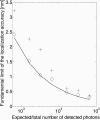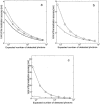Localization accuracy in single-molecule microscopy
- PMID: 14747353
- PMCID: PMC1303911
- DOI: 10.1016/S0006-3495(04)74193-4
Localization accuracy in single-molecule microscopy
Erratum in
- Biophys J. 2004 Aug;87(2):1399
Abstract
One of the most basic questions in single-molecule microscopy concerns the accuracy with which the location of a single molecule can be determined. Using the Fisher information matrix it is shown that the limit of the localization accuracy for a single molecule is given by, lambda(em)/2pi n(a) square root of gammaAt, where lambda(em), n(a), gamma, A, and t denote the emission wavelength of the single molecule, the numerical aperture of the objective, the efficiency of the optical system, the emission rate of the single molecule and the acquisition time, respectively. Using Monte Carlo simulations it is shown that estimation algorithms can come close to attaining the limit given in the expression. Explicit quantitative results are also provided to show how the limit of the localization accuracy is reduced by factors such as pixelation of the detector and noise sources in the detection system. The results demonstrate what is achievable by single-molecule microscopy and provide guidelines for experimental design.
Figures






References
-
- Betzig, E. 1995. Proposed method for molecular optical imaging. Opt. Lett. 20:237–239. - PubMed
-
- Bobroff, N. 1986. Position measurement with a resolution and noise limited instrument. Rev. Sci. Instrum. 57:1152–1157.
-
- Born, M., and E. Wolf. (1999). Principles of Optics. Cambridge University Press, Cambridge, UK.
-
- Chalfie, M., Y. Tu, G. Euskirchen, W. W. Ward, and D. C. Prasher. 1994. Green fluorescent protein as a marker for gene expression. Science. 263:802–805. - PubMed
Publication types
MeSH terms
Substances
Grants and funding
LinkOut - more resources
Full Text Sources
Other Literature Sources
Medical

